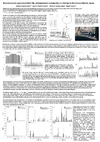Identificador persistente para citar o vincular este elemento:
https://accedacris.ulpgc.es/jspui/handle/10553/72809
| Título: | Environmental Assessment from the Phytoplankton Community in a Marina in the Canary Islands, Spain | Autores/as: | García-Rojas, Andrea Martín García, Jose Antonio López Rueda, Maira Liset Luque Escalona, Ángel |
Clasificación UNESCO: | 241705 Biología marina | Fecha de publicación: | 2013 | Conferencia: | Estuaries and coastal areas in times of intense change (ECSA 53) | Resumen: | Environmental Assessment from the Phytoplankton Community in a Marina in the Canary Islands, Spain García-Rojas A, J A Martin-García , M J Rueda-López and A Luque*. Departamento de Biología, Facultad de Ciencias de Mar, Universidad de Las Palmas de Gran Canaria, Edificio de Ciencias Básicas, Campus Tafira, 35017, Las Palmas, Spain. * Corresponding Author aluque@dbio.ulpgc.es The phytoplankton community gives a fast response to changes in the quality of sea water, by what is considered an effective tool for the evaluation of alterations of the marine environment and to understand the dynamics between the natural environment and the artificial structures. The aim of this work was evaluated the quality of the sea water in a marina “Pasito Blanco”, Gran Canaria, Canary Islands, Spain. The marina has a linear dock 400 m long and a mouth of 45 m with a surface 43,045 m2 of confined waters and a depth between 3 and 7 meters. It has 388 points mooring for boats from six meters to 40 meters in length, being its level of occupation virtually 100% throughout the year. From March 2009 to February 2010T (monthly) in eight points, distributed internal and externally to the harbor, water samples were collected. Oxygen, nitrate, phosphate, silicate and chlorophyll-a concentrations, sea water temperature and salinity and the identification and quantification of organisms of the phytoplankton community were made. The inner zone had the highest concentrations of all nutrients and chlorophyll-a. The phosphate concentrations ranged between 0.26 and 4.48 μMol with the highest in August. The nitrate concentrations ranged from 0.810 to 39.62 μMol, with highest concentrations in November and February. The silicate concentrations ranged from 0.57 to 11.75 μMol, with high significant temporal variability. The chlorophyll-a concentrations ranged from 0.05 to 2.27 μ L-1 and showed in July the largest concentration. The accumulation of nutrients in the inner part of the harbor, promotes algal blooms caused by the diatoms Thalassiosira sp and Guinardia striata, the dinoflagellate Prorocentrum triestinum, and the prasinophyceans and cryptophyceans. It is concluded that the confinement of water in a port system like the one studied, negatively affect the coastal ecosystem. | URI: | https://accedacris.ulpgc.es/handle/10553/72809 | Fuente: | Estuaries and coastal areas in times of intense change (ECSA 53), Shanghai, China |
| Colección: | Póster de congreso |
Visitas
91
actualizado el 14-dic-2024
Descargas
37
actualizado el 14-dic-2024
Google ScholarTM
Verifica
Comparte
Exporta metadatos
Los elementos en ULPGC accedaCRIS están protegidos por derechos de autor con todos los derechos reservados, a menos que se indique lo contrario.
